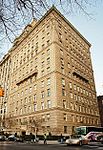The New York City Department of Parks and Recreation, also called the Parks Department or NYC Parks, is the department of the government of New York City responsible for maintaining the city's parks system, preserving and maintaining the ecological diversity of the city's natural areas, and furnishing recreational opportunities for city's residents and visitors.NYC Parks maintains more than 1,700 public spaces, including parks, playgrounds and recreational facilities, across the city's five boroughs. It is responsible for over 1,000 playgrounds, 800 playing fields, 550 tennis courts, 35 major recreation centers, 66 pools, 14 miles (23 km) of beaches, and 13 golf courses, as well as seven nature centers, six ice skating rinks, over 2,000 greenstreets, and four major stadiums. NYC Parks also cares for park flora and fauna, community gardens, 23 historic houses, over 1,200 statues and monuments, and more than 2.5 million trees. The total area of the properties maintained by the department is over 30,000 acres (120 km2). The largest single component of parkland maintained by the department is the 2,765-acre (1,119 ha) Pelham Bay Park in the Bronx. Other large parks administered by NYC Parks include Central Park in Manhattan, Prospect Park in Brooklyn, Van Cortlandt Park in the Bronx, Flushing Meadows–Corona Park in Queens, and the Staten Island Greenbelt.NYC Parks produces many special events, including concerts and movie premieres. In the summer, the busiest season, the agency organizes free carnivals and concerts, and sends mobile recreation vans to travel throughout the five boroughs providing free rental equipment for skating, baseball, and miniature golf.
The symbol of the department is a cross between the leaf of the London plane and a maple leaf. It is prominently featured on signs and buildings in public parks across the city. The London plane tree is on NYC Parks' list of restricted use species for street tree planting because it constitutes more than 10% of all street trees.









